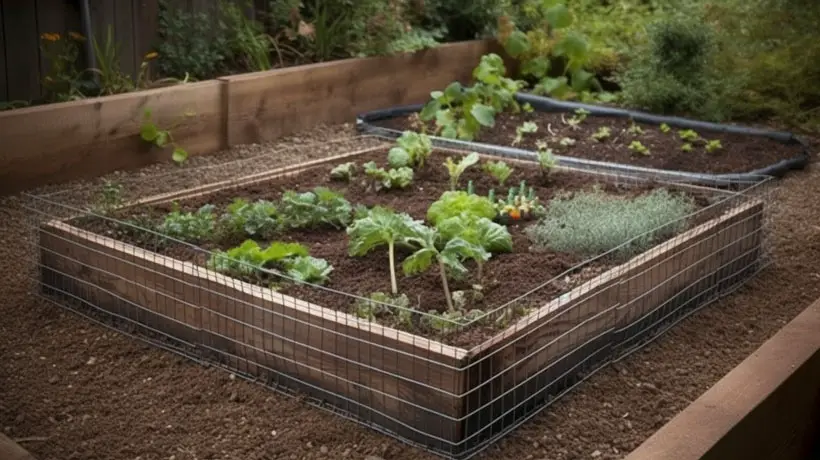How to Keep Gophers Out Of Raised Beds: Guide to Protect Your Plants
Look, by nature, gophers love to chomp on juicy veggies and plants. No wonder these backyard pests are a big problem for farmers and gardeners. And these critters spend most of their time underground in intricate tunnels that can stretch up to 500 feet long!
So, it’s obvious that they can wreak havoc on your raised beds, leaving your plants in disarray. And since you’re here, you must be searching for rescue from them. Well, we’ll share how to keep gophers out of raised beds.
Initially, you can install hardware cloth or gopher wire under your raised beds to deter gophers. Also, there is landscape cloth and cardboard that you can combinedly use to prevent gophers. As an added security, it’d be best to utilize repellent products.
That’s not all; we’ll go through every step of installation along with other plant protection methods. You’ll also get to know different repellent products and some crucial regulations so that you don’t get into trouble. So, let’s get started!
Preventing Gophers From Entering Raised Beds
As a gardener, you must know how to keep gophers out of raised beds. Otherwise, your garden might end up a nuisance with poor pest management. Here are the tips you should follow to keep these pesky rodents out of your garden.

Tips for Preventing Gophers From Entering Raised Beds
Here are some tips to keep these pesky rodents out of your raised garden beds!
- Use Hardware Cloth
When it comes to preventing gopher damage in raised beds, hardware cloth is our first choice. It’s a wire mesh that’s both inexpensive and simple to work with.

You can get it at your local garden supply stores and use it to line your planter box. Its steel elements and weave make it practically impossible for those sneaky gophers to chew through.
- Use Gopher Wire
This is just a fancy term for a metal mesh that’s typically made from 20 gauge wire and has a hexagonal shape. To stop gopher species from plant damage, simply put them a few inches under the bed.
When utilizing it for raised beds, place a 1 to 2-inch layer of topsoil over the mesh before laying down sod or soil. Gopher wire is more costly than hardware cloth but more durable.
Use of Different Materials to Create Barriers
One option you can try is using landscape fabric or weed barrier cloth as a non-toxic technique for gopher control. It’s easy to use and adds an extra layer of protection to your gardening beds alongside hardware cloth.
Now, if you’re struggling with pests and weeds, you can combine cardboard and hardware cloth to get the benefits of both materials at once.
But remember, never use plastic as a barrier to line your garden beds, as it can harm your plants’ roots due to poor drainage.
How to Properly Install and Secure Barriers

Before we guide you through the installation process, gather the tools you’ll need —
Required Tools
- A drill driver
- 2-inch screws
- A hammer or mallet
- A staple gun
- Landscape staples
- Gloves
- Wooden stakes
- Wire shears
Installation Process for Smaller Planter Boxes
When it comes to installing gopher wire or hardware cloth for smaller planter boxes, here’s what you need to do —
- First, lay the box bottom side up.
- Next, attach the wire directly to the bottom edge of the frame.
- Then, roll out the wire and staple it to the opposite edge of the box.
- After that, use wire shears to cut off any excess wire.
- Once that’s done, staple the wire to the sides of the box.
- Don’t forget to tap all the staples down with a hammer to make sure the wire is secure.
- Finally, flip the box over and fill it with soil.
Installation Process for Larger Turf Areas
If you’re planning to install mesh barriers for larger areas, you’ll need to —
- Step 1: Prepare the area by smoothing it out and placing the frame on the ground.
- Step 2: Put wooden stakes around the perimeter and secure them by tapping them into position before driving them all the way in.
- Step 3: Lay out the wire and staple it to one end of the frame, cutting off any excess wire.
- Step 4: Flatten the wire against the ground and staple it to the frame, overlapping the seams by at least 2 inches.
- Step 5: Pin the wire to the ground every 18 inches at the perimeter and every 24 inches at the interior overlaps.
- Step 6: You’ll need to add more staples to keep the wire flat against the ground.
- Step 7: Once stapling and flattering are done, cover the wire with a layer of soil about 1 to 1.5 inches deep.
- Step 8: Finally, you can plant whatever you want, knowing you’ve got gopher-proof raised beds!
Protecting Plants from Gophers
Though mesh barriers and landscape cloth can greatly save your plants from gophers, there are other options that you may like. They’re —

Use Wire Cage
If you don’t want to drop mad cash on a whole wire setup, just grab some baskets made of tough-as-nails galvanized steel. Just put a cage around the plants that need the most protection.
These baskets are usually made of tough galvanized steel and form a strong barrier around the plant’s roots. As a result, it’ll become a hard nut to crack for those pesky gophers to get through.
Grow in Containers
You can use containers, pots, or even wine barrels in your garden which will be keeping gophers away from plants.
Containers not only help control gophers, but they can also solve other problems like soil-borne diseases and poorly drained soil. Plus, they’re easy to move around if you need to rearrange your garden.
Soil Amendments and Repellents
Even if you’ve done all effective gopher control for raised beds, you must use repellents for added security. Some of the repellents you can use are as follows.

Castor Oil Granules
Just sprinkle them over the parts of your yard that are the most gopher-infested and then water them in. The granules will release an underground scent that gophers and even moles can’t stand, so they’ll pack up and leave your yard alone.
To get the best results, you should spread out the castor oil granules gradually across your yard. Begin from the farthest area and move towards the exit every other day.
Grab a broadcast, hand-held, or drop spreader if you want to get the job done right. Typically, you’ll need to sprinkle 1 lb. of granules per 1,000 square feet. but don’t just take our word for it; flip the bag over and find the right spreader setting.
Loud Sound
If you’re looking for a quick fix, try blasting some loud music or hanging up wind chimes. Gophers hate loud noises, so they might just move along. This solution isn’t a long-term fix, so don’t expect it to solve all your problems.
Repellent Products
Some use scent to ward off these pesky critters, but it can be tough to get it deep enough underground where they live. If you want to give it a shot, make sure you get that stuff in every hole you see.
Aside from that, you can try out the following things —
- Garlic Stakes: These stakes contain garlic oil and can be placed in gopher holes across your yard.
- Chili Powder: Sprinkle it down the hole as far as you can.
- Fabric Softener Sheets: Just tuck them in the hole.
- Pine Disinfectants: Dunk a rag and cram it in the hole.
- Peppermint Oil: Soak some cotton fibers and shove them in a gopher hole.
How to Properly Apply Repellents to Be Effective?
To get the best results for wildlife removal, you must know how to apply repellents. It’s super important that you stick to the instructions on the label. That means:
- Make sure to put your repellents as close to the gopher tunnels as possible.
- Drench your castor-oil repellents so they seep into those pesky tunnels
- Re-apply repellents every now and then to keep the gophers at bay
- Dig a small hole in the ground and press the device into it so you don’t put too much pressure on the ultrasonic repellent. This will help it stay in place without disrupting the surrounding soil or damaging the device.
- Give your solar-powered exposure to direct sunlight daily so it stays always charged.
Trapping and Removal of Gopher From Your Garden

You can use the following ways to trap and remove gophers from your garden.
Use Live Traps
One well-known way to do it is by using live traps. To do that —
- Step 1: You must get rid of all their food sources to lure them into the trap with some bait.
- Step 2: Peanut butter is a great choice for bait, but put it behind the trigger plate of the trap.
- Step 3: Remember to check the trap in the morning and at night.
- Step 4: If you catch a gopher, make sure to release it safely.
- Step 5: Most importantly, you can keep them from coming back by tidying up your yard and removing anything that could attract them, like debris and birdseed.
Use Lethal Traps
There are mainly two lethal traps that are used widely.
- Two-Pronged Pincer
The Macabee, Gophinator, or Cinch are some examples of these 2-pronged pincer traps. Once the gopher pushes against a vertical pan, flat, or metal wire, the trap is triggered, and the gopher meets its doom.
- Choker-Style Box
This type of trap, unlike the two-pronged pincer, operates by suffocating the gopher inside the trap’s enclosed box. Although it’s also placed in the primary tunnel, the choker-style box trap is typically larger, requiring extra surface digging for installation.
Considerations and Regulations Regarding Trapping and Removing Gophers
Well, if you’re in Washington State, there are some trapping regulations you need to keep in mind. For instance, the use of snares or body-gripping traps is prohibited, except for mice. But don’t worry; you can use box-type traps legally.

Plus, if you plan to use a trap followed by fumigation with aluminum phosphide pellets, you’ll need a license from your state.
So, if baiting and trapping don’t work, you may want to consider hiring a professional pest control guy who has a permit to get aluminum phosphide.
But remember, new regulations restrict its use in residential areas. But keep in mind that recent rules limit its usage in residential areas. It may only be used well over 100 feet away from any structure containing domestic animals, people, or both.
Since it’s best used in parks and sporting fields, it may not be suitable for most residential homes.
If you’re looking for ways to keep gophers out of your raised beds, be sure to check out our article on how to keep gophers out of raised beds. Additionally, if you’re curious about the sounds gophers make, our article on what sound gophers make offers insights into their vocalizations. Finally, if you’re concerned about gophers getting into your house, our article on whether gophers can get into your house provides information on their behavior and habits. Our piece on what sound gophers make offers information on their vocalizations, while our article on whether gophers can get into your house offers insights into their behavior and what you can do to prevent them from entering.FAQs
In this section, we’ve added two more frequently asked queries by people regarding the gophers.
Q. Can gophers climb into raised beds?
They can’t climb higher than a foot over a fence as long as your raised bed has an enclosed bottom with hardware cloth or gopher wire. If you have a fence, bend it at a 90-degree angle, so even if they try to climb, they won’t get in.
Q. Are there any plants that gophers won’t eat?
There’s a list of plants given below that gophers won’t munch on. But make sure to do research on each plant before you buy them. Certain plants may irritate some people while not others.
Check these out: Columbine, Ceanothus (California lilac), Artemisia (wormwood), Rock Rose, Foxglove, Breath of Heaven, Lavender, Lantana, and Rosemary. Also, the native perennial Salvias, Thrift, Strawberry Tree, Yarrow, Manzanita, Bear Berry, and Privet.
Final Words
It’s critical to keep gophers out of raised beds in order to maintain healthy plants. We’ve discussed a variety of efficient techniques, such as placing wire mesh at the bottom, utilizing sonic repellers, and, of course, traps. To avoid gopher infestations, consider pest prevention steps and respond quickly.
It’s also important to research local regulations and avoid using harmful pesticides that can harm beneficial insects and contaminate the soil. By following proper wildlife management, you can successfully secure your garden.
Last but not least, if things seem complicated enough for you, you can contact one of the experienced pest control companies to do the job for you.




